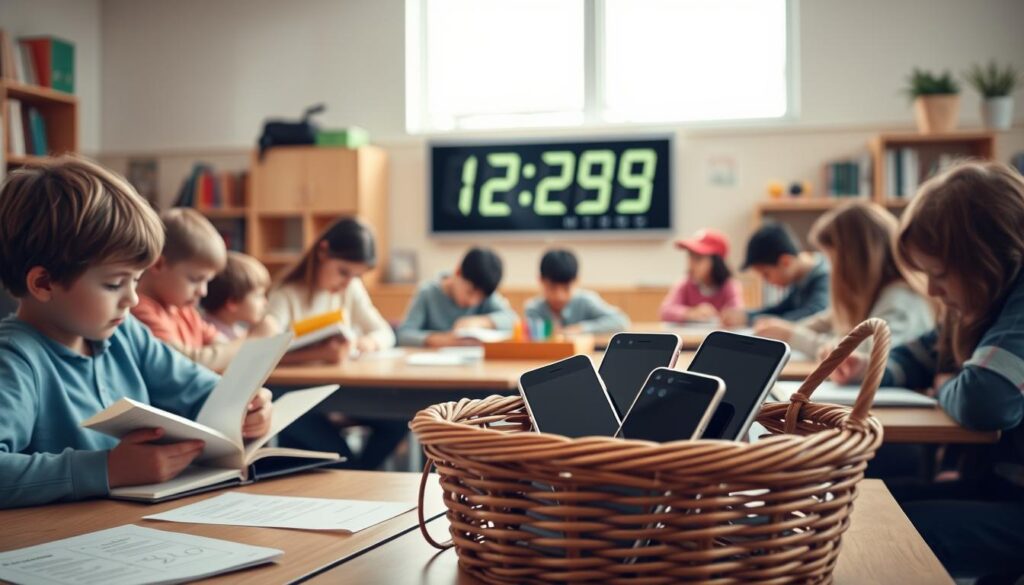How to Help Students Disconnect from Phones Today
In today’s world, smartphones are a big part of our lives. Students find it hard to balance tech use and learning. Social media, messaging apps, and online distractions can hurt their grades, social skills, and health.
As teachers and parents, we must help students put down their phones. We need to create a better learning space. This space should be focused, engaged, and productive.
فهرس المقالة
Understanding the Impact of Phone Addiction on Student Learning
In today’s world, smartphones are everywhere. They pose a big challenge for students and teachers. Excessive phone use can harm students’ health, learning, and social skills. It’s key to know how phone addiction affects us to make phone-free learning and tech-free classrooms work.
Physical and Mental Health Effects
Looking at screens for too long can cause eye strain, headaches, and neck pain. Phones also distract and stimulate, leading to anxiety, depression, and less focus.
Academic Performance Decline
Phones can pull students away from learning. They get caught up in social media and messaging. Studies link phone use in class to lower grades and less learning.
Social Development Challenges
Too much phone use can make it hard to develop social skills. Students may struggle to interact face-to-face, show empathy, and communicate well. They might find it tough to make real connections and handle social situations.
| Impact | Consequence |
|---|---|
| Physical and Mental Health | Eye strain, headaches, anxiety, depression |
| Academic Performance | Lower grades, reduced attention and retention |
| Social Development | Difficulty with face-to-face interaction, empathy, and communication |
It’s vital to tackle phone addiction in schools. By understanding its effects, we can help students stay healthy and succeed in their studies. Educators and leaders can then create phone-free learning and tech-free classrooms to support students.
Creating Phone-Free Learning Environments in the Classroom
Creating unplugged education in the classroom is key to helping students stay away from their phones. It helps them use technology mindfully. Teachers can use many ways to make classrooms where phones are not allowed. This helps students focus, get involved, and do well in school.
One good way is to have special places for phones. Students put their phones there when they’re in class. This stops distractions and helps students pay attention to what’s happening in class.
- Use a phone caddy or locker for students to put their phones before class starts.
- Make clear rules about using personal devices during the school day.
- Ask students to keep their phones in the special place and not use them until class or the school day ends.
Another idea is to make some parts of the classroom phone-free. This lets students work together, talk, and do activities without phones. These areas or times are when phones are not allowed.
- Choose parts of the classroom that are good for phone-free talks and group work.
- Have “screen-free” times in class for activities without phones.
- Encourage students to stay in the moment and not check their phones during these times.
By using these methods, teachers can make a space for unplugged education and mindful technology use. This helps students concentrate better and understand the value of balancing tech and learning.
“The ability to focus is a superpower in today’s distracted world. Creating phone-free learning environments can unlock the full potential of our students.”
Establishing Clear Digital Device Policies and Guidelines
Schools are working hard to limit screen time and fight phone addiction. They need clear rules for digital devices. These rules help students focus on learning without distractions from their phones.
Setting Boundaries for Phone Usage
Good digital device policies set limits on phone use at school. They might say phones are only allowed during breaks or not in class. This helps students learn to use their phones wisely and stay focused.
Implementing Consequences and Rewards
Schools need to have rules and rewards for phone use. Breaking the rules might mean losing your phone for a while. But, using it wisely can earn you special perks. This way, students learn to use technology responsibly.
Communicating with Parents and Guardians
It’s not just about the rules; talking to parents is key. Schools should work with families to keep screen time in check at home and school. This teamwork helps students stay on track everywhere.
| Strategies for Effective Digital Device Policies | Benefits |
|---|---|
|
|
By using these strategies, schools can make learning better. They help students stay focused and develop good tech habits. This prepares them for a world filled with technology.

Helping Students Disconnect from Phones Through Alternative Activities
In today’s world, it’s key to give students fun, phone-free learning chances. This helps them grow and connect with others. By doing this, we help them see the world beyond their screens.
Outdoor learning is a great way to do this. Activities like hiking, camping, and helping the environment can spark curiosity. They also get kids moving and teach teamwork. These activities help students enjoy nature and learn to appreciate it.
Hands-on projects and creative activities are also great. Things like woodworking, pottery, or painting murals can spark creativity. They help kids solve problems and feel proud of what they make. These activities offer a break from screens and help students connect with each other.
Team-building exercises and challenges are also helpful. Scavenger hunts, escape rooms, or working together on problems teach teamwork. They show the value of working together and using communication skills. These activities help students learn to rely on each other, not just their phones.
By adding these activities to school, we help students put down their phones. This approach improves their learning and helps them feel better overall. It prepares them for a world where they can use technology wisely.
| Alternative Activity | Benefits |
|---|---|
| Outdoor Learning | Connects students with nature, promotes physical activity, and encourages teamwork |
| Hands-on Projects | Stimulates creativity, develops problem-solving skills, and fosters a sense of accomplishment |
| Team-building Exercises | Enhances communication, collaboration, and interpersonal skills |
“Unplugging from technology can be a transformative experience, allowing students to rediscover the joys of hands-on learning and meaningful social interaction.” – Dr. Emma Keller, Education Researcher
Incorporating Mindful Technology Use in Education
Our use of technology is growing fast. It’s key to use it wisely in schools. By teaching mindful technology use and digital wellness practices, teachers help students use tech well. They learn to handle digital life in a healthy way.
Teaching Digital Wellness Practices
Adding digital wellness lessons to school curriculums is important. It helps students know how to use tech wisely. They learn about:
- Managing time to avoid too much screen time
- How to stay focused despite digital distractions
- Good ways to communicate online and on social media
- The value of taking breaks from tech
Promoting Balanced Tech Habits
Teachers also help students develop balanced tech habits. They do this by:
- Setting rules for using devices in class
- Mixing digital and non-digital learning
- Showing and teaching good tech habits
- Working with parents to keep tech habits consistent
Understanding Digital Citizenship
Teaching digital citizenship is vital. It prepares students to use the internet wisely. They learn about:
- Keeping personal info safe online
- Being kind and respectful online
- The effects of their online actions
- How to deal with cyberbullying
By focusing on mindful technology use and digital wellness, we help students. They learn to use tech in a healthy way. This boosts their well-being and school success.
Developing Strategies for Managing Device Distraction
Students face a big challenge in managing device distraction. It’s key to find ways to stop phone addiction in schools. Using productivity apps is a great start. Apps like Forest, Freedom, and StayFocusd help students stay focused by blocking websites and setting timers.
The Pomodoro Technique is another helpful method. It involves working in short, focused periods with breaks in between. This technique helps students stay on track and avoid digital distractions.
Having a phone-free study area is also beneficial. A “no-phone zone” helps students focus better. It’s also important to be mindful of how much time is spent on devices. This way, students can control their phone use and stay focused.
| Strategy | Description | Benefits |
|---|---|---|
| Productivity Apps | Apps that block websites, set timers, and provide distraction-free modes | Helps create a focused work environment, reduces temptation to engage with devices |
| Pomodoro Technique | A time management method that alternates between focused work and short breaks | Trains the brain to maintain attention and avoid digital distractions |
| Designated Study Spaces | Creating device-free zones for focused work and study | Helps the brain associate certain areas with productive, distraction-free activities |
| Self-Awareness and Self-Regulation | Developing mindfulness and control over device usage habits | Empowers students to take charge of their attention and digital habits |
By using these strategies, students can better manage device distraction. This helps them stay focused and improve their grades and well-being.

“The key to managing device distraction is to create an environment that supports focused work and to develop the self-awareness necessary to regulate our digital habits.”
Building Support Systems for Digital Detox
Helping students disconnect from phones needs teamwork. Schools and communities can help students develop good tech habits. Here are three strategies that can really help.
Peer Support Groups
Peer support groups are key for digital detox for students. They bring together people who want to use their phones less. In these groups, students can share their stories, give tips, and support each other.
Teacher-Student Mentoring Programs
Teacher-student mentoring programs are very effective for fostering digital wellness. They match students with teachers or counselors for support. These mentors can give advice, check on progress, and be a trusted source for students.
Family Involvement Initiatives
Getting families involved in digital detox for students is essential. Schools can start programs to teach parents about digital wellness. They can also give tools for phone-free times at home and help students talk about their phone use.
With these support systems, schools and communities can help students manage their digital lives. This leads to better digital wellness and success in today’s tech world.
“The true sign of intelligence is not knowledge but imagination.” – Albert Einstein
Measuring Success in Reducing Phone Dependency

It’s important to check if efforts to reduce phone use in students are working. By using both qualitative and quantitative methods, teachers can learn a lot. This helps them improve how they teach limiting screen time for students and unplugged education.
One way to do this is by asking students for their thoughts and feelings about phone use. Surveys can show if students feel better without phones. They might say they focus more, interact better, and do better in school.
Teachers also look at things like grades, how often students come to class, and any problems with behavior. These numbers show if the efforts to cut down on phone use are making a difference.
Watching how students act in class and during other activities is also helpful. It shows if they can put down their phones and do other things.
| Assessment Method | Metrics | Advantages |
|---|---|---|
| Student Surveys |
|
|
| Academic Performance Tracking |
|
|
| Behavioral Observations |
|
|
By always checking how well their efforts are working, teachers can make their plans better. They can tackle new problems and make sure students get the most out of technology in a smart way.
“The goal is not to demonize technology, but to help students develop a healthy and sustainable relationship with it.”
Addressing Common Challenges and Resistance
When trying to reduce phone addiction in schools, you’ll face some challenges. Students might not like phone rules, and parents could have worries. Also, setting up technical solutions can be tricky. But, with teamwork and flexibility, you can overcome these hurdles.
Student Opposition to Phone Restrictions
Students might not want to give up their phones at first. They’re used to always having them. So, it’s key to involve them in making rules. Explain why phones can be a distraction and offer fun, phone-free activities.
By talking openly and listening to students, you can win their support. They’ll see the value in taking breaks from phones.
Parent Concerns and Solutions
Parents might worry about limiting their kids’ phone use. They might think it’s needed for staying in touch or for school work. To ease these worries, create clear rules and involve parents in the process.
Find ways to balance school needs with what parents want. This could mean setting phone times, offering other ways to communicate, and teaching about the benefits of phone-free time.
Technical Implementation Issues
Setting up phone-free zones in schools can be technical. You’ll need to block devices, check if rules are followed, and make sure everyone has access to tech. Work with your IT team and look for good digital tools.
Make policies that work for everyone. This way, you can make your phone-free learning plans work smoothly.
FAQ
What are the key benefits of helping students disconnect from their phones?
Helping students put down their phones can improve their health and grades. It also helps them make better friends. By doing this, students can focus more in class and sleep better. They also get to enjoy real-life conversations more.
How can educators create phone-free learning environments in the classroom?
Teachers can make classrooms phone-free by setting up special spots for phones. They can also have tech-free times during the day. This makes students more present and helps them learn better without distractions.
What are some effective strategies for setting and enforcing digital device policies in schools?
Setting clear rules for phone use is key. Teachers can use rewards and penalties to keep students on track. It’s also important to tell parents about these rules. This way, everyone knows and follows the rules, both at school and at home.
How can students be encouraged to disconnect from their phones through alternative activities?
Getting students to put down their phones can be done through fun activities. Outdoor learning, hands-on projects, and team games are great. These activities help students connect with others and learn new things without phones.
What are the key elements of incorporating mindful technology use in education?
Teaching students about digital wellness is important. This includes learning how to use technology wisely and understanding digital rights. By teaching these skills, students can use technology in a responsible way and stay focused.
How can students develop strategies for managing device distraction?
Students can fight distractions by using apps and the Pomodoro Technique. Having a quiet study area without phones helps too. Learning to control phone use is essential for staying focused and avoiding addiction.
What types of support systems can help students succeed in their digital detox efforts?
Support groups and mentor programs are great for students. So is getting family involved. Having a strong support network helps students stay on track with their digital detox goals.
How can the success of strategies to reduce phone dependency be measured?
Measuring success can be done through surveys and tracking grades. Observing behavior is also helpful. Regularly checking how well these strategies work helps make them better over time.
How can educators address common challenges and resistance when implementing phone disconnection strategies?
Dealing with student and parent concerns is important. Being flexible and open helps solve problems. Working together to find solutions ensures phone disconnection strategies work well.






